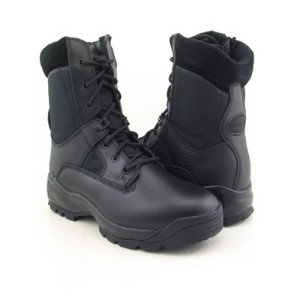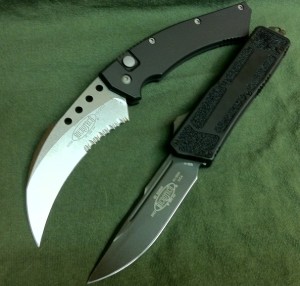The response to our short shoe knife tutorial / info-piece has been great, and we have come to realize that there were a few (a little bit obvious) things left out. So here’s another stab (pun intended) at the legendary shoe knife, and how you could be the proud owner of one. Or a pair of them, if you think that’s going to be a better match.
First of all, let’s have this out of the way; as with the other article this is simply for novelty, informational and educational purposes. We do not in any way shape or form condone the carrying of concealed weapons unless for legitimate, legal purposes. Should you choose to follow any advice or information presented on this site, you do that on your own risk. Carrying an illegal, concealed weapon will land you in jail if you’re caught with it. Also, having a criminal record is never a good thing. In short, read this, be educated and don’t try it at home. Onwards!
Why should you reinvent the wheel?
The short answer is that you shouldn’t, of course. It’s been proven to work the way it is. What you should do is strive to find new uses for it, uses that makes sense to you and helps you in your quest. Or whatever. The main challenge we presented in the making of the shoe knife was the trigger function. Having a reliable trigger function is what makes or breaks this concept, as with so many others. You have to be able to trigger the blade, make it appear in order for it to do its business, and then be able to retract it again should you have a need to use the shoe in a normal fashion. You can’t run anywhere with a blade sticking out of the tip of your shoe,

dumbass.
From time to time sine that first artivle was published, we’ve gotten questions about it, suggestions (some interesting, some pretty much oka, and a lot of just silly ones) and pointers to where further information can be obtained. There’s surprisingly little usable info out there about this kind of setup, this kind of weapon, in light of the exposure it has gotten through movies and films, and that’s what we’re going to change.
Okay, so what do we suggest?
Well, there’s this thing you might have heard of, called a switchblade. It’s a nifty little thing, with a blade hidden in the handle which springs out at the push of a button. The blade can be retracted with the same mechanism so that it’s hidden in the handle once more.
The absolute easiest way to build a shoe knife will be to use a shoe that has a thick enough sole to accomodate the whole blade, and position the blade’s trigger so that it can be extended to the exterior of the shoe. The limitation to this, of course, is that the trigger mechanism will be rather close to the front of the shoe (assuming that’s where you would want the blade to extend from), but the simplicity of the setup makes up for this drawback.
Choosing your boots is the first step – yes, it has to be boots, because they’re the only shoes with a thick enough sole to accomodate the setup in a comfortable way, and which are also versatile enough to actually be useful. A dress shoe might be good if you’re playing poker with a few millionaires and you find yourself in a situation where you have to stab a couple of them, but that’s a long-shot for most of us. So, boots it is. How about these? We like’em.
Next up is getting a suitable switchblade. Some people call them “automatic knives”, but the ones who do is usually in or approaching their 90’s. So we’ll go with switchblade.

Here’s another catch – unless you’re in Austria, you could get in serious trouble (most likely) for buying or posessing a switchblade. They’re legal here and there, but usually with restrictions on length, type of blade, where it’s sharpened and so on. Best check this out for yourself before you go asking around for one. There are a few manufacturers out there that make quality switchblades, and most of them are pretty expensive, but there’s always cheaper knockoffs available (online, for that matter).
One tip – if you do get caught with a switchblade, try the “I’m a collector” line – it usually won’t work, but it’s your best shot. In some places the posession of one of these is legal if you’re a collector, LEO or military personell. Fair warning.
Setting up your very own Shoe Knife!
Okay, so you’ve got the shoes and you’ve got the switchblade. Now what?
Well, you’ll need a drill. To hollow out the sole on your selected boot. Kinda obvious. Make sure you take precise measurments – measure twice, cut once. Well, drill once. Remember that you’ll have to drill a second hole from the side, where you’ll extend the trigger out to the outside of the sole. Also, make sure you do this on the right side of the boot (not necessarily the right, as opposed to the left, but the right as opposed to the wrong). Make sure it’s a tight fit if you don’t want to use glue to fix the knife in there.
Fitting a trigger is the easiest part. You should now have the knife in the sole of the boot, and it’s trigger lined up with the second hole you drilled in from the side. Simply insert a tight-fit hard plastic plug in the hole, making sure it’s long enough to reach the trigger. Don’t worry about operating it – the knife’s own trigger will push it back out. The only thing you need to do is fit catches so the damn thing doesn’t fall out when you’re using the shoes.
Essentially, you’re done. Voila, your very own shoe knife! Click your shoes together and you won’t be back in Kansas, but you’ll have a blade pop out of your shoe as if you were 007 himself.

First off, the best type of switchblade is the kind with a blade that comes straight out and has a flat trigger or toggle.
Second, get the type of boot that has a thick sole and is GLUED on, very important.
The cheap semi-hard molded kind is perfect.
You will need to pull apart the sole from the shoe and once you have done this will see why a cheap shoe or boot is needed.
There are wells or honeycombs where the sole has nothing but air, perfect for what we want to do.
Mount the knife nearly to the tip of the shoe but where the toggle is just ahead of the big toe by a fraction of an inch.
you are going to cut a small slot just ahead of your big toe in the shoe proper and it is very important that your toe rest fully on the sole of the boot.
Carefully cut the slot as directed and duct tape the knife in place, making sure that the knife is far enough back to be fully inside the sole but far enough forward for comfortable operation.
This fitting process can easily take the entire day.
Once you are sure that things are right trace the outline of the knife on the shoe sole and carefully cut out from the bottom sole a cavity for the knife.
A small slot will need to be cut and this is best done with a sharp box cutter, from the outside front.
Everything needs to be snug from the sides but able to flex up and down as you walk.
For this reason the knife needs to be in a slot and the hole for the toggle needs to be a slot ahead of the toe.
You are going to glue only the front portion of the knife to the front of the shoe, allowing the blade to move of course.
Everything else is allowed to flex to some degree with the knife moving with the steps.
You need to extend your big toe to operate this, meaning you need to put your foot down and press forward, than operate the knife.
The knife I used is around 6 inches long and is in a Vosque Sundowner hiking boot that is 1/2 size too big, OK as I have made a leather innersole that works perfect.
This was an entire weekend project and except for the one boot being a bit stiff it works fine.
But it is very important for the knife to be free in a vertical motion to allow for the shoe to flex and not bind.
What about a dress shoe?
Can you make a video of this by chance?
?????-????????? , ???